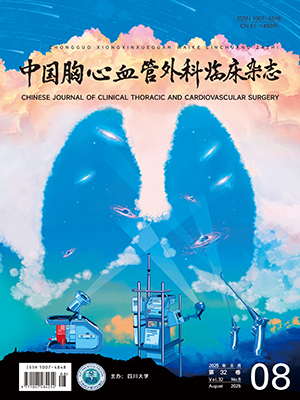| 1. |
Popov AF, Coskun KO, Tirilomis T, et al. Mechanical aortic valve replacement in children and adolescents after previous repair of congenital heart disease. Artif Organs, 2009, 33(11):915-921.
|
| 2. |
Panda BR, Shank ar R, Kuruvilla KT, et al. Combined mitral and aortic valve replacement for rheumatic heart disease:Fifeen-year follow up and long-term results. J Heart Valve Dis, 2009, 18(2):170-179.
|
| 3. |
Rafi DY, Davies RR, Carroll SJ, et al. Age less than two years is not a risk factor for mortality afer mitral valve replacement in children. Ann Torac Surg, 2011, 91(4):1228-1234.
|
| 4. |
Arnold R, Ley-Zaporozhan J, Ley S, et al. Outcome afer mechanical aortic valve replacement in children and young adults. Ann Torac Surg, 2008, 85(2):604-610.
|
| 5. |
Losenno KL, Gelinas JJ, Johnson M, et al. Defining the efficacy of aortic root enlargement procedures:a comparative analysis of surgical techniques. Can J Cardiol, 2013, 29(4):434-440.
|
| 6. |
Ackermann K, Balling G, Eicken A, et al. Replacement of the systemic atrioventricular valve with a mechanical prosthesis in children aged less than 6 years:Late clinical results of survival and subsequent replacement. J Thorac Cardiovasc Surg, 2007, 134(3):750-756.
|
| 7. |
David TE. Reoperations after Ross Procedure. Circulation, 2010, 122:1139-1140.
|
| 8. |
Raghuveer G, Caldarone CA, Hills CB, et al. Predictors of prosthesis survival, growth, and functional status following mechanical mitral valve replacement in children aged < 5 years, a multi-institutional study. Circulation, 2003, 108(suppl 1):Ⅱ174-Ⅱ179.
|
| 9. |
Kojori F, Chen R, Caldarone CA, et al. Outcomes of mitral valve replacement in children:a competing-risks analysis. J Thorac Cardiovasc Surg, 2004, 128(5):703-709.
|
| 10. |
Henaine R, Nloga J, Wautot F, et al. Long-term outcome after annular mechanical mitral valve replacement in children aged less than fve years. Ann Torac Surg, 2010, 90(5):1570-1576.
|
| 11. |
Caldarone CA, Raghuveer G, Hills CB, et al. Long-term survival afer mitral valve replacement in children aged < 5 years:a multiinstitutional study. Circulation, 2001, 104(12 Suppl 1):I143-I147.
|
| 12. |
Alsoufi B. Aortic valve replacement in children:Options and outcomes. J Saudi Heart Assoc, 2014, 26(1):33-41.
|
| 13. |
Miceli A, Duggan SM, Capoun R, et al. A clinical score to predict the need for intraaortic balloon pump in patients undergoing coronary artery bypass grafing. Ann Torac Surg, 2010, 90(2):522-526.
|
| 14. |
Ranucci M, Ballotta A, Castelvecchio S, et al. Perioperative heart failure in coronary surgery and timing of intra-aortic balloon pump insertion. Acta Anaesthesiol Scand, 2010, 54(7):878-884.
|
| 15. |
Bonios MJ, Pierrakos CN, Argiriou M, et al. Increase in coronary blood flow by intra-aortic balloon counterpulsation in a porcine model of myocardial reperfusion. Int J Cardiol, 2010, 138(3):253-260.
|
| 16. |
刘浩, 丁芳宝, 黄健兵, 等.主动脉内球囊反搏在主动脉瓣轻、轻中度反流患者中的应用.中国胸心血管外科临床杂志, 2012, 19(1):48-51.
|
| 17. |
肖荣冬, 翁国星, 谢维泉, 等.感染性心内膜炎的围术期治疗和危险因素分析.中国胸心血管外科临床杂志, 2014, 21(1):128-131.
|
| 18. |
Alexiou C, Galogavrou M, Chen Q, et al. Mitral valve replacement with mechanical prostheses in children:improved operative risk and survival. Eur J Cardiothorac Surg, 2001, 20(1):105-113.
|
| 19. |
Alexiou C, McDonald A, Langley SM, et al. Aortic valve replacement in children:are mechanical prostheses a good option? Eur J Cardiothorac Surg, 2000, 17(2):125-133.
|
| 20. |
Mokhles MM, Körtke H, Stierle U, et al. Survival comparison of the Ross procedure and mechanical valve replacement with optimal self-management anticoagulation therapy:propensity-matched cohort study. Circulation, 2011, 123(1):31-38.
|




